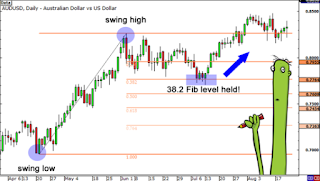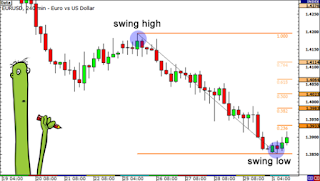Let's talk about Fibonacci levels of retracement.
Fibonacci retracement levels are horizontal lines that show potential price reversal levels.
The Fibonacci technique works best when the market is trending, which is the first thing you should know about it.
When the market is heading up, the aim is to go long (or purchase) on a pullback near a Fibonacci support level.
Read Also: Traditional Japanese Candlestick Chart vs. Heikin Ashi Candlestick Chart
When the market is going DOWN, go short (or sell) on a pullback at a Fibonacci resistance level.
Because they attempt to foretell where price will be in the future, Fibonacci retracement levels are considered a predictive technical indicator.
According to the theory, after price starts a new trend direction, it will retrace or return partway to a previous price level before continuing in the trend direction.
Levels of Fibonacci Retracement
You must first locate recent key Swing Highs and Swing Lows in order to locate these Fibonacci retracement levels.
Click on the Swing High and drag the mouse to the most recent Swing Low for downtrends.
When it comes to uptrends, the opposite is true. Drag the pointer to the most recent Swing High by clicking on the Swing Low.
Got that?
Read Also: Traditional Japanese Candlestick Chart vs. Heikin Ashi Candlestick Chart
Now, let’s take a look at some examples of how to apply Fibonacci retracement levels to the currency markets.
Uptrend
This is a daily chart of AUD/USD.
Daily chart of AUD/USD with Fibonacci retracement levels
Here we plotted the Fibonacci retracement levels by clicking on the Swing Low at .6955 on April 20 and dragging the cursor to the Swing High at .8264 on June 3.
Tada! The charting software automagically calculates and shows you the retracement levels.
Read Also: Traditional Japanese Candlestick Chart vs. Heikin Ashi Candlestick Chart
As you can see from the chart, the Fibonacci retracement levels were .7955 (23.6%), .7764 (38.2%), .7609 (50.0%*), .7454 (61.8%), and .7263 (76.4%).
Now, the expectation is that if AUD/USD retraces from the recent high, it will find support at one of those Fibonacci retracement levels because traders will be placing buy orders at these levels as price pulls back.
*The 50.0% ratio is not officially a Fibonacci ratio, but it was able to sneak into the group and has never left.
Now, let’s look at what happened after the Swing High occurred.
Fibonacci Retracement: 38.2% Fib level held as support
Read Also: Traditional Japanese Candlestick Chart vs. Heikin Ashi Candlestick Chart
Price pulled back right through the 23.6% level and continued to shoot down over the next couple of weeks.
It even tested the 38.2% level but was unable to close below it.
Later on, around July 14, the market resumed its upward move and eventually broke through the swing high.
Clearly, buying at the 38.2% Fibonacci level would have been a profitable long-term trade!
Downtrend
Now, let’s see how we would use the Fibonacci retracement tool during a downtrend. Below is a 4-hour chart of EUR/USD.
4-hour chart of EUR/USD with Fibonacci retracement levels
As you can see, we found our Swing High at 1.4195 on January 25 and our Swing Low at 1.3854 a few days later on February 1.
Read Also: Traditional Japanese Candlestick Chart vs. Heikin Ashi Candlestick Chart
The retracement levels are 1.3933 (23.6%), 1.3983 (38.2%), 1.4023 (50.0%), 1.4064 (61.8%) and 1.4114 (76.4%).
The expectation for a downtrend is that if the price retraces from this low, it could possibly encounter resistance at one of the Fibonacci levels because traders who want to play the downtrend at better prices may be ready with sell orders there.
Let’s take a look at what happened next.
Fibonacci Retracement: 50.0% Fib level held as resistance
Yowza! Isn’t that a thing of beauty?!
The market did try to rally, stalled below the 38.2% level for a bit before testing the 50.0% level.
If you had some orders either at the 38.2% or 50.0% levels, you would’ve made some mad pips on that trade.
In these two examples, we see that price found some temporary forex support or resistance at Fibonacci retracement levels.
Because of all the people who use the Fibonacci tool, those levels become self-fulfilling support and resistance levels.
If enough market participants believe that a retracement will occur near a Fibonacci retracement level and are waiting to open a position when the price reaches that level, then all those pending orders could impact the market price.
One thing you should take note of is that price won’t always bounce from these levels. They should be looked at as areas of interest, or as Cyclopip likes to call them, “KILL ZONES!” We’ll teach you more about that later on.
For now, there’s something you should always remember about using the Fibonacci tool and it’s that they are not always simple to use!
Read Also: Traditional Japanese Candlestick Chart vs. Heikin Ashi Candlestick Chart
If they were that simple, traders would always place their orders at Fibonacci retracement levels and the markets would trend forever.












0 Comments